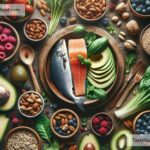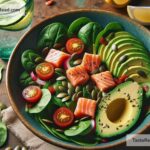Foods That Reduce Risk of Muscle Atrophy
Muscle atrophy is the loss of muscle mass and strength over time. It can happen for many reasons, such as lack of exercise, aging, or medical conditions like injuries or certain diseases. Losing muscle isn’t just about looking weaker—muscles play a crucial role in moving our bodies, maintaining balance, and even supporting our overall health. While exercise is the best way to keep your muscles strong, what you eat can also make a big difference. There are foods that can help preserve your muscles and reduce the risk of atrophy. Below, we’ll explore some of the best foods for keeping muscles healthy.
1. Protein-Rich Foods
Protein is the building block of muscles, so it’s no surprise that eating foods high in protein is essential for preventing muscle atrophy. Protein helps repair and rebuild muscle tissue after it’s broken down during physical activity. Without enough protein, your body may struggle to maintain muscle mass.
Good Protein Sources:
- Chicken, turkey, and lean beef: These meats are packed with high-quality protein to nourish your muscles.
- Fish: Fish like salmon, tuna, and mackerel are great protein sources and also contain omega-3 fatty acids (more on these later).
- Eggs: Eggs are affordable and versatile, with all the essential amino acids your body needs.
- Beans and lentils: Plant-based proteins like beans, lentils, and chickpeas are perfect for vegetarians or anyone looking to reduce their meat consumption.
- Dairy products: Milk, yogurt, and cheese provide protein along with calcium, which supports muscle function.
Tip: Pair protein-rich foods with a balanced diet to maximize their impact. Eating enough protein daily can help prevent muscle loss, especially as you age.
2. Omega-3 Fatty Acids
Omega-3 fatty acids are healthy fats found in certain foods, and they play an important role in muscle health. These fats can reduce inflammation in your body, which is helpful for preventing muscle breakdown caused by injury or illness. Studies also suggest that omega-3s may boost the process of muscle protein synthesis, helping your body build and maintain muscle.
Good Sources of Omega-3s:
- Fatty fish: Salmon, sardines, and trout are top sources of omega-3s.
- Flaxseeds and chia seeds: These seeds are plant-based options full of omega-3s and fiber.
- Walnuts: Walnuts make a great snack packed with omega-3s and other nutrients.
- Edamame: This soybean product is a surprising source of omega-3s.
Adding omega-3s to your diet can help strengthen your muscles, reduce inflammation, and even improve heart health—all important for staying active and strong.
3. Foods Rich in Vitamin D
Vitamin D plays a major role in muscle health. Without enough vitamin D, your muscles can become weak and more prone to atrophy. Vitamin D helps your body absorb calcium, which is essential for muscle function and maintaining bone health. Many people don’t get enough of this vitamin, especially during winter months when sunlight is limited, so adding vitamin D-rich foods to your diet can help.
Good Sources of Vitamin D:
- Fatty fish: Salmon and mackerel again make the list!
- Egg yolks: Egg yolks contain a small amount of vitamin D, making them a great breakfast option.
- Fortified foods: Some cereals, orange juices, and dairy products are fortified with vitamin D. Check the label to make sure!
- Mushrooms: Some types of mushrooms, like maitake, are naturally high in vitamin D.
Tip: Spending time in sunlight is another excellent way to increase vitamin D levels. Pairing a healthy diet with sunshine can go a long way in preventing muscle loss.
4. Antioxidant-Rich Foods
Antioxidants help protect your cells from damage caused by free radicals. Muscle atrophy can be accelerated by chronic inflammation and oxidative stress, so eating antioxidant-rich foods can be helpful to slow muscle loss.
Good Sources of Antioxidants:
- Colorful fruits: Berries (blueberries, strawberries, raspberries), oranges, and cherries are packed with antioxidants.
- Dark leafy greens: Spinach and kale not only provide antioxidants but also nutrients like magnesium, which is key for muscle recovery.
- Nuts and seeds: Almonds, sunflower seeds, and pumpkin seeds contain vitamin E, a powerful antioxidant.
- Green tea: Green tea is known for its antioxidant properties and can be a soothing addition to your day.
Including a variety of antioxidant-rich foods in your meals will help your body fight inflammation and keep muscles strong.
5. Foods High in Magnesium
Magnesium is an essential mineral for muscle function. It helps your muscles contract and relax while also contributing to energy production during workouts. Without enough magnesium, you may experience muscle cramps, weakness, or fatigue—all signs of potential atrophy over time.
Good Sources of Magnesium:
- Whole grains: Brown rice, quinoa, and oats are excellent sources of magnesium.
- Nuts and seeds: Almonds, peanuts, and sunflower seeds are magnesium-packed snacks.
- Dark chocolate: Dark chocolate (preferably 70% or higher cacao) contains magnesium and can be an enjoyable treat.
- Avocados: Avocados are great for magnesium and healthy fats.
Adding magnesium-rich foods to your diet can improve muscle strength and help prevent cramps and spasms that can lead to muscle breakdown.
Conclusion
Preventing muscle atrophy isn’t just about hitting the gym—it’s also about focusing on what’s on your plate. Protein-rich foods, omega-3 fatty acids, vitamin D, antioxidants, and magnesium can all contribute to healthier muscles and reduce the risk of losing muscle mass. Eating a variety of these foods regularly, along with staying active, will help you keep your muscles strong for years to come.
Remember, keeping your body and muscles healthy starts with making small, consistent choices every day. Pick foods that nourish your muscles, and pair them with regular exercise to preserve strength and keep atrophy at bay. Your future self will thank you!

